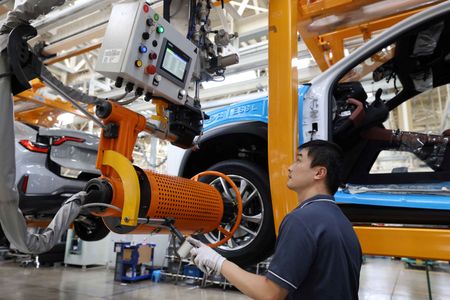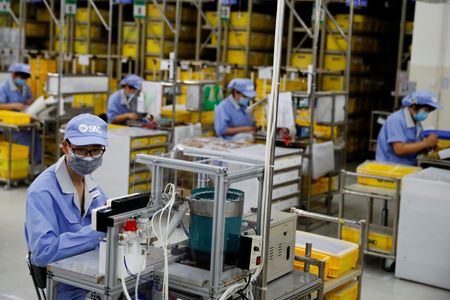


BEIJING (Reuters) – China’s factory activity weakened in October as protracted COVID-19 restrictions disrupted production and subdued demand, a private-sector survey showed on Tuesday, suggesting a weaker economic recovery in the fourth quarter.
The Caixin/S&P Global manufacturing purchasing managers’ index (PMI) stood at 49.2 in October, up from 48.1 in September and slightly above analysts’ expectations for 49.0. But the figure was still below the 50-point mark that separates growth from contraction on a monthly basis.
In line with China’s official PMI, which unexpectedly fell into contraction last month, waning factory activity weighed on the fragile recovery of the world’s second-biggest economy amid a deepening property crisis and weakening demand.
Both output and new orders extended declines at the start of the fourth quarter as a pickup in COVID-19 clusters and stringent containment measures dragged on any meaningful rebound, the PMI showed.
Supplier delivery times lengthened as surveyed firms attributed transportation delays to virus containment measures.
The softer activity continued to pressure the labour market as the manufacturing employment fell for the seventh month in a row.
“The current domestic and international environments remain complicated and tough, and unfavourable factors affecting economic development have increased,” said Wang Zhe, an economist at Caixin Insight Group.
“In particular, the spread of the coronavirus in many regions significantly restricts both supply and demand,” Wang said.
Officials in Chinese cities and provinces are pulling no punches in stamping out sporadic COVID outbreaks as winter nears, quickly closing venues including Shanghai Disney Resort and enforcing longer lockdowns on millions of people.
A vast assembly facility of iPhone maker Foxconn in COVID-hit Zhengzhou in central China has been rocked by discontent over stringent anti-virus measures, with workers fleeing the site over the weekend.
Analysts see China’s current zero-COVID policy as a major economic constraint and expect restrictions to stay in place for some time following October’s Communist Party Congress.
With global interest rate hikes and the Ukraine war clouding external demand for Chinese goods, the index of new export orders shrank for the third consecutive month, highlighting the downside risks for exports.
The Caixin manufacturing PMI centres on small firms and coastal regions where sit a great number of exporters.
(Reporting by Ellen Zhang and Ryan Woo; Editing by Sam Holmes)

